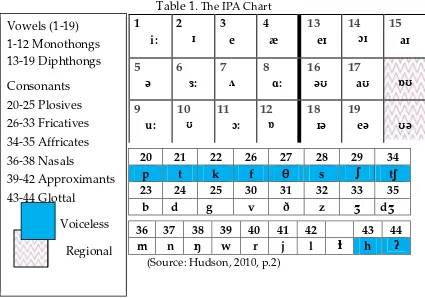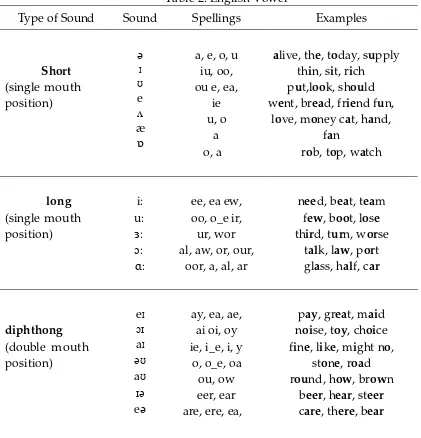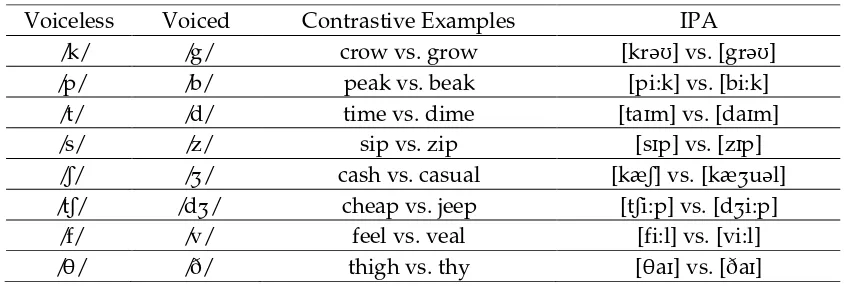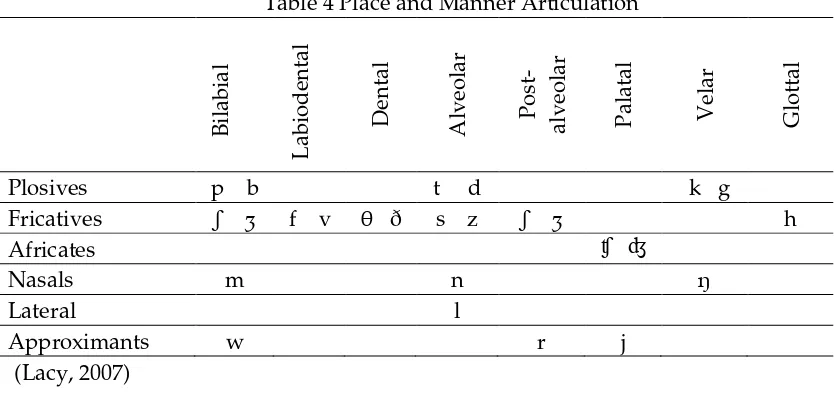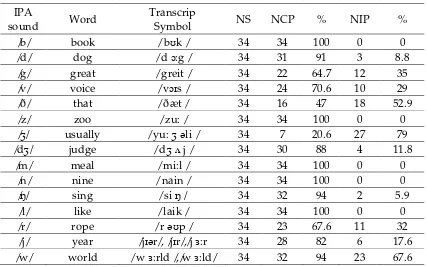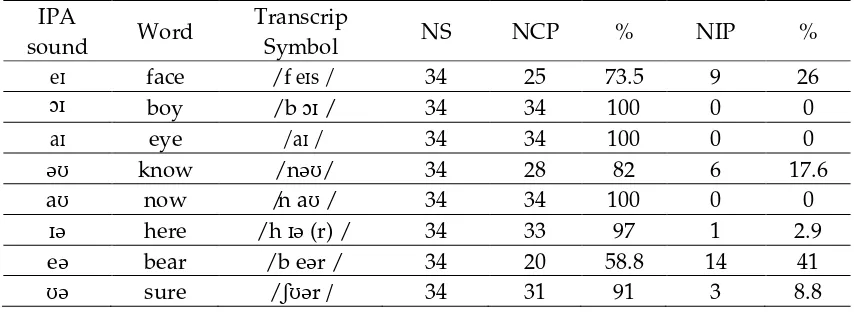Teaching English pronunciation through international phonetic
alphabet symbol at MAN - 1 Murung Raya
Najamudin naja1779@yahoo.com
State Islamic High School 1 of Murung Raya
Jl. KH. Ahmad Dahlan No.1 Puruk Cahu, Central Kalimantan,Indonesia
Abstract
This study is intended to help the teachers in teaching learning process particularly for English pronunciation. It is the most important component to get English speaking fluently. Therefore, all the students who learn English language must master the pronunciation. In Indonesia, most of the students from Senior high school or Islamic High School get trouble in learning and practicing English pronunciation. For that reason, the writer tries to solve those problems with this study. The study of the pronunciation of words is part of the field of phonetics. Phonetics is special symbols to represent each different speech sound. It is spelling system that closely matches the sounds represented. It is also said that phonetics is the study of speech sounds and how they are produced. This study explains why English pronunciation is very difficult to be learned especially for Indonesian students and how the English sounds are produced. This study uses descriptive analysis methodology. The result of the study is by learning pronunciation through International Phonetic Alphabet or IPA symbol, the students will get not only the same pronunciation with American English speakers but also British English speakers. The students who know the IPA will know how to pronounce any words in English.
Keywords: English pronunciation, International Phonetic Alphabet, symbol
INTRODUCTION
All over the world, there are many people with strong desire to learn and speak English with correction pronunciation. Millions people study English Pronunciation, but only few succeed. English as a foreign language pronunciation teaching is usually based on teaching materials presenting one of the two main standard accents namely British and American.
the students learn in this symbols will enable them to think in a very concrete way about what actually occurs as they make sounds. By learning the IPA (International Phonetic Alphabet), hopefully their knowledge of pronunciation will be converted from a more passive into a more active state and that is exactly what we need to be effective teachers. By using and viewing pronunciation in a different light, they should acquire a better feel for the mechanisms that are used in the vocal process and hopefully find their English
voice. Using IPA can be tricky at first, but when we are good at it, our
pronunciation will improve.
Ladefoged and Johnson (2010, p.33) say that many people think that learning phonetics means simply learning to use phonetic transcription. But there is really much more to the subject than learning to use a set of symbols. A phonetician is a person who can describe speech, who understands the mechanisms of speech production and speech perception, and who knows how languages use these mechanisms. Phonetic transcription is no more than a useful tool that phoneticians use in the description of speech. It is, however, a very important tool.
Teaching pronunciation involves a variety of challenges. To begin with, teachers often find that they do not have enough time in class to give proper
attention to this aspect of English instruction. The Problem with English is
letters don’t represent sounds. No one knows what words sound like from reading them.The objectives of the study are formulated as follow, 1) to get the students pronounce English better. 2) to give the students the ability how to produce the sounds.3) to compare pronunciation of correct and incorrect sounds.
of high quality, suitable teaching and learning materials, and the lack of time to practice pronunciation are the major reasons that cause teachers not to pay enough attention to English pronunciation. Teachers should teach their learners that slow speech with correct pronunciation is much better than fast speech with wrong pronunciation.Teachers should familiarize their learners to both American and British English and learners should be able to understand both varieties of pronunciation (Rasekhi Kolokdaragh, 2010).
Giedrė (2014, p.7-8) states that internationally, there are many varieties of English as it is spoken worldwide as a first or a second official language as a first language it is spoken in the United Kingdom, The United States of America, Canada, Ireland, Australia, New Zealand, South Africa, and some islands in Central America. Today all english- speaking nations have their own national varieties of English. A national variety is defined as the speech of nation, e.g. British English, American English, Australian English, Canadian English. the pronunciation of English in America is different from most accent found in Britain. Each national variety holds its standardised language as standard English, American English. English has become an international language not only because it is used by so many people all over the world, but also because it has developed into the essential means of global communication, embracing access to the world’s intellectual and technical resources.
Giedė (2014, p.13 ) states that phonetics and phonology are the branches of linguistics concerned with sounds, thus the main object of investigation in this course is a sound. The English alphabet is comprised of 26 letters, while the sound system of English contains 44 sounds as phonemes. Both branches investigate the sounds from different perspectives. Crystal 2008, p.363) defines phonetics is concerned with the physical manifestation of language in sound waves and how they are produced, transmitted, and perceived, and also “provides methods for their description, classification, and transcription” (as cited in Giedrė 2014,p.13). Phonology “studies the sound systems of languages” (as cited in Crystal 2008, p. 365) and how sounds function in relation to each other in a language (Yoshida, 2005, p.17) defines phonology is the study of speech sounds in language—the sounds themselves, how they are produced, and how they work together as a system in a particular language.
Vowels (1-19) with an example word to show where each sound occurs.They are * /p/ as in pig
* /f/ as in fun * /θ/ as intheory * /s/ as in soon * /ʃ/ as inship * /t/ as in tank * /k/ as Diphthongs), and consonant (vioce and voiceless).
Table 1. The IPA Chart have been compiled from the International Phonetic Alphabet (IPA) devised by International Phonetic Association (also abbreviated IPA). The association was established in 1886, and since then, it has been functioning as the major as well as the oldest representative organisation for world phoneticians. The
association’s mission is to promote the scientific study of phonetics by providing phoneticians worldwide with a notational standard for the phonetic representation of all languages, i.e. the IPA. Learning to use IPA symbols is very important part of phonetics.
Pronunciation
Cook (1996) as cited in Pourhosein Gilakjani (2016) defined pronunciation as the production of English sounds. Pronunciation is learnt by repeating sounds and correcting them when produced inaccurately. When learners start learning pronunciation they make new habits and overcome the difficulties resulting from the first language. According to Yates (2002 as cited in Pourhosein Gilakjani, 2016), pronunciation is the production of sounds that is used for making meaning. Grammar and vocabulary are important elements of language and they can be useless if the speakers cannot pronounce those elements or words accurately.
There are two main types of sounds in English; consonants and vowels. They can be differentiated mainly in their manner of articulation. There are 24 consonant sounds in Standard American English. Because sound systems, are above all, systematic, it is important to know how and where they are made in the mouth. All vowels in English are voiced. Dale and Poms (2005, p.4) states a vowel is a speech sound produced with vibrating vocal cords and a continues unrestricted flow of air coming from the mouth . the most well – known vowels in English are: A, E, I, O, U. The various vowel sounds are affected by the changing shape and position of your articulators. The different vowels are created by: 1.the posiiton of your tongue in the mouth. For example , the tongue is high in the mouth for vowel [i] as in “see” , but is low the mouth for the vowel [a] as in “[hot]”.2. the shape of your lips. For example . the lips are very rounded for the vowel [u] as in “new”, but are spread for [i] as in “see”.3. the size of your jaw opening. For example , the jaw is open much wider for [a]as in “[hot]” than it is for the diphthong [ei] as in “[pay]”. A neutral English accent has 19 vowel sounds. There are 3 types of English vowel sound - short, long
and diphthong. English s p e l l i n g does not always show us which sound to
Table 2. English Vowel
Type of Sound Sound Spellings Examples
Short alphabet that is not a vowel. Consonants are produced by stopping the air from flowing easily through the mouth, especially by closing the lips or touching the teeth with the tongue. (Beregszász 2014, p. 58) states that a consonant letter usually represents one consonant sound. Some consonant letters, for example, c, g , s, can represent two different consonant sounds. C letter can be pronounced
as /c/ sound like “cheap” [tʃi:p] and also as /k/ sound as in “cream”[ kri:m] and
“creep” [kri:p]. G letter can be pronounced as /g/ sound like get [get] and also as
“sister”[sistər] and also as /ʃ/ sound like “sugar” [ʃ ʊgər]. English consonant sound there are two types, voiced and voiceless. Voice sounds occur when the vocal cords vibrate when the sound produced. There is no vocal cord vibration when producing voiceless sounds.
Table 3. Voiceless and voiced consonant sounds in English
Voiceless Voiced Contrastive Examples IPA
/k/ /g/ crow vs. grow [krəʊ] vs. [grəʊ]
/p/ /b/ peak vs. beak [pi:k] vs. [bi:k]
/t/ /d/ time vs. dime [taɪm] vs. [daɪm]
/s/ /z/ sip vs. zip [sɪp] vs. [zɪp]
/ʃ/ /ʒ/ cash vs. casual [kæʃ] vs. [kæʒuəl] /tʃ/ /dʒ/ cheap vs. jeep [tʃi:p] vs. [dʒi:p]
/f/ /v/ feel vs. veal [fi:l] vs. [vi:l]
/θ/ /ð/ thigh vs. thy [θaɪ] vs. [ðaɪ]
(Hietanen, 2012)
Place of Articulation
The place of articulation is the description of where the obstruction occurs in the vocal tract. To describe a place of articulation of a consonant, the lower articulator articulates with which of the upper articulators must be stated. Bilabial: Both lips touch or almost touch. The sounds in this group are /p/, /b/, /m/, and /w/. Labiodental: The upper teeth softly touch the lower lip. The sounds in this group are /f/ and /v/. Dental (also called interdental): The tip of the tongue touches the bottom edge of the top teeth or between the teeth. The sounds in this group are /θ/ and /ð/. Alveolar: The tip of the tongue touches or almost touches the alveolar ridge (the tooth ridge). The sounds in this group are /t/, /d/, /s/, /z/, /n/, and /l/. Palatal (also called alveopalatal): The blade of the tongue touches or almost touches the hard palate. The sounds in this group are
/ʃ/, /ᴣ/, /ʧ/, /ʤ/, /r/, and /y/. Velar: The back of the tongue touches the soft palate.
The sounds in this group are /k/, /g/, and /ŋ/. Glottal: There is friction in the
glottis (the space between the vocal cords). The only phoneme in this group is /h/.
Manner of Articluation
manner of articulation is how those various speech organs interact with each other, providing a further dimension to how consonants are articulated. The manners of articulation for English consonants are listed below.
Stops (also called plosives): The air stream is blocked completely somewhere in the mouth, air pressure builds up, and then it’s released, like a tiny explosion. The stops in English are /p/, /b/, /t/, /d/, /k/, and /g/.
Fricatives: The air stream is compressed and passes through a small opening in the mouth, creating friction— a hissing sound. The air stream is never completely blocked, so the sound can continue.
The fricatives are /f/, /v/, /θ/, /ð/, /s/, /z/, /∫/, /ᴣ/, and /h/. Affricates: A combination of a stop followed by a fricative—an explosion with a slow release.
The a"ricates are /ʧ/ and /ʤ/. Each of these symbols is made up of two parts—a
stop symbol and a fricative symbol. This reminds us that the sounds also have two parts.
Nasals: In these sounds, the tongue or lips block o" the vocal tract so air can’t go out through the mouth. Instead, the passage leading up into the nose opens so that the air stream can go out through the nose. The sounds in the
nasal group are /m/, /n/, and /ŋ/. Liquids: These are sounds that are pronounced
very smoothly, like water flowing in a river. The air stream moves around the tongue in a relatively unobstructed manner.
The liquid sounds in English are /l/ and /r/. Glides (also called semivowels): A glide is like a very quick vowel. This is why they’re sometimes called semivowels, which means “half-vowels.” They sound like vowels, but they can function as consonants. The glides in English are /w/ (which sounds like a quick /uw/) and /y/ (which sounds like a quick /iy/).
Table 4 Place and Manner Articulation
METHOD
This study uses descriptive analysis methodology. Participant of this study were the students of MAN 1 Murung Raya. The total sample is 34. persons. Since this study dealt with English pronunciation, to find the answer of this study, qualitative and quantitative method was applied by teaching English pronunciation through International Phonetics Alphabet symbol at MAN 1 Murung Raya. The writers described the data in words, phrases or sentences to obtain general conclusion from the subject of the study. The population of this study was the tenth-grade students of State Islamic High School 1 of Murung Raya. The total number of the students from one class as the sample of this study was 34 students. The samples were taken from the students of MAN 1 Murung Raya since the writer has been teaching English subject to the students.
In this study, the writer collected the data through primary of sources data and secondary sources of data. They are observation, questionnaire, interview, and oral test. Overall, data collected were analyzed both statistically or quantitative and descriptively or qualitative. The writers prepared an example of consonant, vowel and diphthong and asked the students to make the phonetic transcription and pronounced the words. In this study, the data were analyzed as in following steps first of all, the writer gave the list of words consisting of 24 consonants, 14 vowels and 7 diphthongs. Next, the students were asked to write the phonetic transcription of the words. Then, the students pronounced the words and to write the English words which was categorized into consonants, vowels and diphthongs. The writer found the most mistake made by the students in pronouncing the consonants, vowels, and diphthongs. The data used in this research were IPA symbol in consonants, vowels,and diphthongs pronunciation. The writer used 4 instruments to collect the data in order to find out the students’ ability pronunciation and analyzed them.
Before beginning on the details of research methodology and techniques, it seems appropriate to present a brief overview of the research process. Research process consists of series of actions or steps necessary to effectively carry out research and the desired sequencing of these steps. The chart shown in Figure 1.
Research process in flow chart
Where = feed back (Helps in controlling the sub-system to which it is transmitted)
= feed forward (Serves the vital function of providing criteria for evaluation
Figure.1 Analysis Diagram (Source: Kothari, 2004) Define reserch problem
Formulate hyphoteses
Analyse data (Test hypotheses if any) Collect data (Execution) Review previous
Research Finding
Design research (Including sample design)
Interpret and report
Review consepts and Theories Review the Literature
VI I
II
V IV III
VII
F
F
F
F F
F
FINDINGS
After analyzing the data, then the findings of this study were specified as follow:
Table 5 Voiced Consonant IPA
sound Word
Transcrip
Symbol NS NCP % NIP %
/b/ book / bʊk / 34 34 100 0 0
/d/ dog / d ɔ:g / 34 31 91 3 8.8
/g/ great / greit / 34 22 64.7 12 35
/v/ voice / vɔɪs / 34 24 70.6 10 29
/ð/ that / ðæt / 34 16 47 18 52.9
/z/ zoo / zu: / 34 34 100 0 0
/ʒ/ usually / yu: ʒəli / 34 7 20.6 27 79
/dʒ/ judge / dʒ ʌ j / 34 30 88 4 11.8
/m/ meal / mi:l / 34 34 100 0 0
/n/ nine / nain / 34 34 100 0 0
/ŋ/ sing / si ŋ / 34 32 94 2 5.9
/l/ like / laik / 34 34 100 0 0
/r/ rope / r əʊp / 34 23 67.6 11 32
/j/ year /jɪər/, /jɪr/,/j ɜ:r 34 28 82 6 17.6 /w/ world / w ɜ:rld /,/w ɜ:ld/ 34 32 94 23 67.6
Percentage showed the participants had no problem with the pronunciation of /b/, /d/, /g/,/v/,/z/, /m/,/n/,/l/,/r/,/j/, /w/. They had to improve the pronunciation of these sounds.
Table 6 Consonant of Voiceless Sound
IPA
sound Word
Transcrip
Symbol NS NCP % NIP %
/p/ person / ‘p ɜ: r s ə n / 34 14 41 20 58.8
/t/ tool / t u: l / 34 30 88 4 11.8
/k/ queen / kwi: n / 34 12 35 22 64.7
/f/ five / faiv / 34 31 91 3 8.8
/θ/ thank / θæŋk / 34 9 26 25 73.5
/s/ school / sku:l / 34 29 85 5 14.7
/ʃ/ sugar / ʃu:gər / 34 26 76 8 23.5
/tʃ/ cheese / tʃi:s / 34 21 61.8 13 38
The result of the study showed that the sounds of /t/, /f/, /s/,/ʃ/, /tʃ/, /h/ were pronounced correctly or there were no problem how to say them.
Table 7 Short Vowel
IPA sound Word Transcrip
Symbol NS NCP % NIP %
ɪ city / ’s ɪti / 34 28 82 6 17.6
ʊ foot / f ʊt / 34 34 100 0 0
ʌ enough / i’n ʌf / 34 23 67.6 11 32
Æ cat / k æt / 34 17 50 17 50
ɒ strong / str ɒŋ / 34 30 88 4 11.8
ə alive / ə’laiv / 34 32 94 2 5.9
It is about 100% the learners had produced the sound of / ʊ/ correctly
and the sound /ʌ / was about 23 %, /ɒ/ was 88% and the sound of /ə/ 94 % was
pronounced correctly.
Table 8 Long Vowel IPA
sound Word
Transcrip
Symbol NS NCP % NIP %
i: knee / ni: / 34 30 88 4 11.8
u: blue / blu: / 34 31 91 3 8.8
ɜ: early / ɜ:rli / 34 27 79 7 20.6
ɑ: arm / ɑ:rm / 34 32 94 2 5.9
ɔ: always / ɔ:lweiz / 34 29 85 5 14.7
The participant of this study there were no problem with those sounds. All long vowel can be pronounced correctly.
Table 9 Diphthong IPA
sound Word
Transcrip
Symbol NS NCP % NIP %
eɪ face / f eɪs / 34 25 73.5 9 26
ɔɪ boy / b ɔɪ / 34 34 100 0 0
aɪ eye / aɪ / 34 34 100 0 0
əʊ know / nəʊ/ 34 28 82 6 17.6
aʊ now /n aʊ / 34 34 100 0 0
ɪə here / h ɪə (r) / 34 33 97 1 2.9
eə bear / b eər / 34 20 58.8 14 41
The result of the study showed that the learners were very good to pronounce diphthong of /eɪ/, /ɔɪ/, /aɪ/, /əʊ/, /aʊ/, /ɪə/, /ʊə/. It was indicated that diphthong sounds were very easy pronounced.
Note: IPA= International Phonetic Alphabet, NS = number of students, NCP= number of students with correct pronunciation, NIP = number of students with incorrect pronunciation.
DISCUSSION
The types of English sound system consisted of consonants, vowels, and diphtongs. The voiced sound that the students made in the consonant /ð/, and /ʒ/ because the participant lack of understanding how to pronounce the word correctly according to IPA transcription. For voiceless sound, the students get difficulties and confuse how to pronounce the word tht contains these letters /p/,/t/,//θ/.The English vowel, in this case, short vowel, the students cannot
understand how this symbol /æ/ and /eə/ pronounced.
Although most of the students could not pronounce the
/ð/,/ʒ/,/p/,/t/,//θ/,/æ/correctly, they still could write down the phonetic
transcription correctly. The students need to broaden minded, to learn lots about international Phonetics Alphabet symbol is not only in classroom but also in outside classroom such as from internet and English courses places.
CONCLUSION
Based on the discussion above, the conclusions are drawn as the following. The students of State Islamic High School 1 of Murung Raya have many mistakes in producing sound in voiced, voiceless, short vowel, long
vowel and diphthongs. Sound mistake lies on /ð/ and /ʒ/ for voiced, /p/,/t/,//θ/
for voiceless sound, /æ/ for short vowel and eə for diphthong sound.
The cause of sound mistake is divided into 2 factors. Linguitics factor such as transfer interlingual, transfer intralingual, pronunciation difference. Meanwhile, mistake by non linguistics factors such as education background, environment, habitual and teacher’ motivation. It is known that linguistics factor has bigger influences to teachers’ pronunciation.
media for listening tasks. The students who have good pronunciation will helps them to have a better understanding of native speakers and improves their ability to communicatee with the others easily and effectively.
REFERENCES
Balčtytė Giedrė – Kurtinienė (2014). A Course in English Phonetics for EFL. Segmental Phonetics. Syllabl .Stress.University Students:Vilnius.
Beregszász , Lászlό . (2014).Put English Phonetic Into Practice (For English Major
College Students). Szilágyi “Department Philology.
Daffue-Karsten, L., H. Luukkonen, K. Moilanen, P. Pollari, K. Venemies & K.
Vincent (2006). English United Course 4. Helsinki: Tammi. Cambrigde
University Press.
Dale Paulette, Poms Lillian (2005).English Pronunciation Made Simple Longman.
Kothari, CR (2004). Research Methodology Methods and Techniques (2nd Revised
Edition). India: New Age International Publisher.
Gilakjani, Abbas Pourhosein. (2012) The Significance of Pronunciation in English
Language Teaching. English Language Teaching. Accessed November 10,
2017. http://www.ccsenet.org/journal/index.php/elt/search/results/.
Harmer Jeremy (2005). The Paractice of English Language Teaching Longman. Third Edition Completely revised and updated.
Hietanen, Hilla(2012).Teaching The Pronunciation of English as an International
Language Suggestions for Constructing a syllabus for Finnish learners. Master's Thesis. Department of Languages English April: University of Jyväskylä.
Hudson Joseph (2010). An English Accent Free Sample. London: Pronunciation
Studio.
Hudson, Josep(2012). The sound of English. A practical course in British English Pronunciation. Interactive E-book with Audio. London: Pronunciation Studio.
Knight Rachael – Anne (2012). A Coursebook. London: Cambridge University Press.
Lacy, P. D. (2007). The Cambridge Handbook of Phonology. Cambridge: Cambridge
University Press.
Ladefoged Peter and Johnson Keith (2010). A Course in Phonetics (6th Edition).
Publisher: Michael Rosenberg.
Yoshida, Marla Tritch Yoshida (2005). Understanding and Teaching the
Authors’ Brief CV
